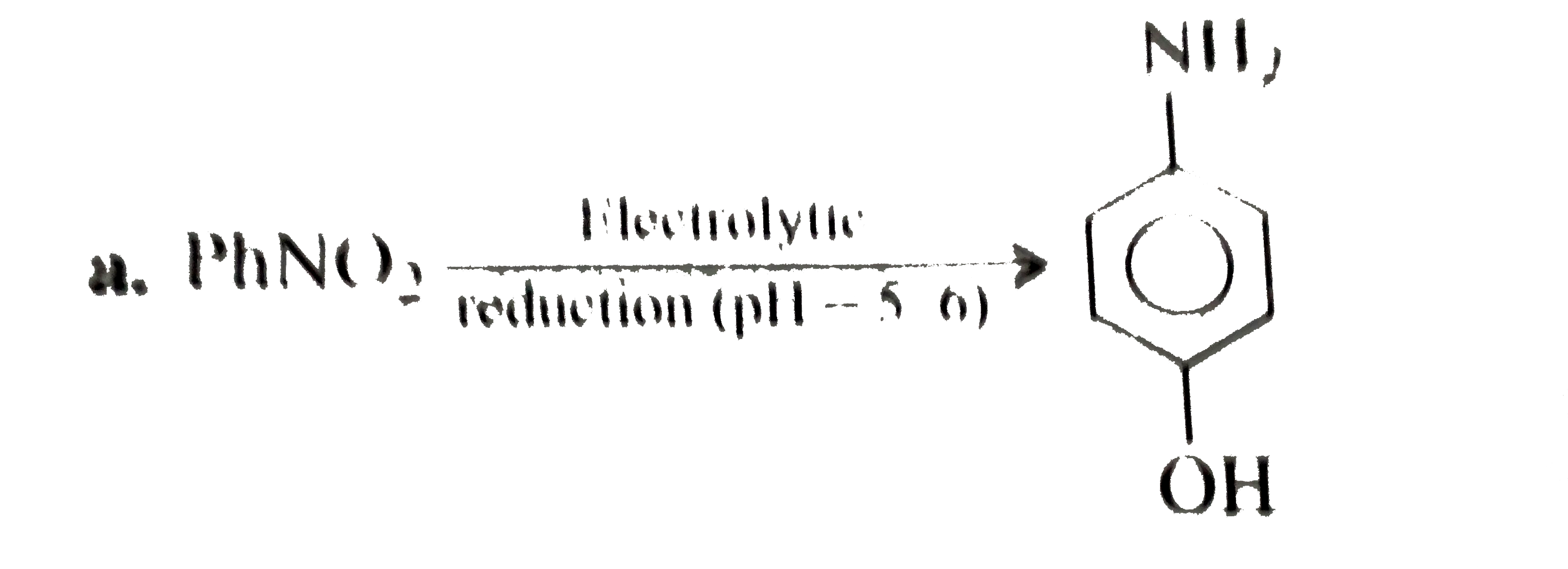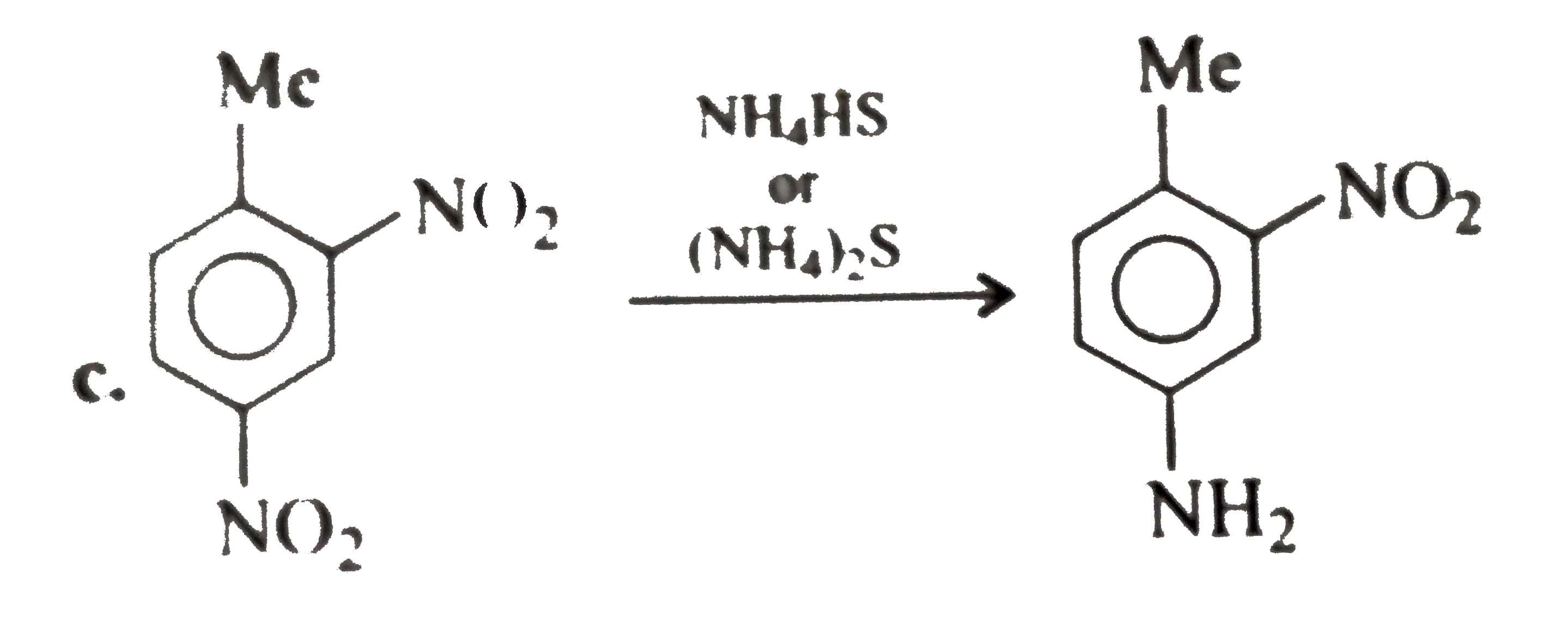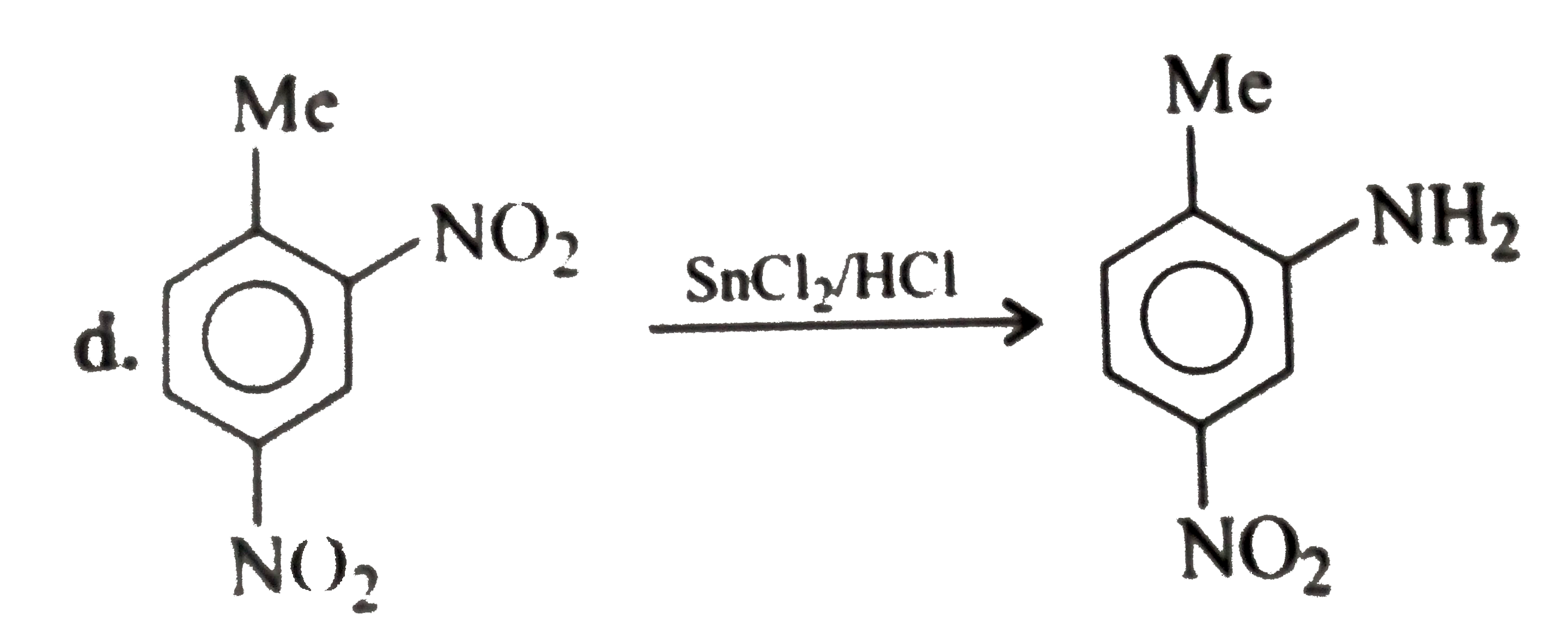Which of the following reaction are wrong?




The correct Answer is:A, B
To determine which reactions are wrong among the given options, we need to analyze the reduction of nitrobenzene and its derivatives under different pH conditions. Here’s a step-by-step solution:
Step 1: Analyze the First Reaction
- Reaction: Nitrobenzene in a neutral medium (pH 5-6).
- Expected Product: The expected product in a neutral medium is N-phenylhydroxylamine (N-H-O-H).
- Conclusion: If the product is stated to be para-aminophenol, this is incorrect. Therefore, the first reaction is wrong.
Step 2: Analyze the Second Reaction
- Reaction: Nitrobenzene in a weakly acidic medium (pH 3-4).
- Expected Product: In a weakly acidic medium, the reduction of nitrobenzene yields aniline (C6H5NH2).
- Conclusion: If the product is stated to be N-phenylhydroxylamine, this is incorrect. Therefore, the second reaction is also wrong.
Step 3: Analyze the Third Reaction
- Reaction: Reduction of ortho-para-dinitrotoluene using ammonium hydrogen sulfide (NH4HS).
- Expected Product: The less sterically hindered nitro group (the one that is less crowded) will be reduced to an amine (NH2).
- Conclusion: If the product is stated to be the amine from the less crowded NO2, this is correct. Therefore, the third reaction is correct.
Step 4: Analyze the Fourth Reaction
- Reaction: Reduction of dinitrotoluene in an acidic medium.
- Expected Product: The nitro group closer to the methyl group will be reduced due to the +I effect (inductive effect) of the methyl group.
- Conclusion: If the product is stated to be the amine from the nitro group closer to the methyl group, this is correct. Therefore, the fourth reaction is also correct.
Final Conclusion
- The reactions that are wrong are:
- Option A: Incorrect product in neutral medium.
- Option B: Incorrect product in weakly acidic medium.
Summary of Wrong Reactions
- The wrong reactions are A and B.
- Reaction: Nitrobenzene in a neutral medium (pH 5-6).
- Expected Product: The expected product in a neutral medium is N-phenylhydroxylamine (N-H-O-H).
- Conclusion: If the product is stated to be para-aminophenol, this is incorrect. Therefore, the first reaction is wrong.
- Reaction: Nitrobenzene in a weakly acidic medium (pH 3-4).
- Expected Product: In a weakly acidic medium, the reduction of nitrobenzene yields aniline (C6H5NH2).
- Conclusion: If the product is stated to be N-phenylhydroxylamine, this is incorrect. Therefore, the second reaction is also wrong.
- Reaction: Reduction of ortho-para-dinitrotoluene using ammonium hydrogen sulfide (NH4HS).
- Expected Product: The less sterically hindered nitro group (the one that is less crowded) will be reduced to an amine (NH2).
- Conclusion: If the product is stated to be the amine from the less crowded NO2, this is correct. Therefore, the third reaction is correct.
- Reaction: Reduction of dinitrotoluene in an acidic medium.
- Expected Product: The nitro group closer to the methyl group will be reduced due to the +I effect (inductive effect) of the methyl group.
- Conclusion: If the product is stated to be the amine from the nitro group closer to the methyl group, this is correct. Therefore, the fourth reaction is also correct.
- The reactions that are wrong are:
- Option A: Incorrect product in neutral medium.
- Option B: Incorrect product in weakly acidic medium.
- The wrong reactions are A and B.
Topper's Solved these Questions
- ORGANIC COMPOUNDS WITH FUNCTIONAL GROUPBOOK - CENGAGE CHEMISTRY ENGLISHCHAPTER - ORGANIC COMPOUNDS WITH FUNCTIONAL GROUPEXERCISE - Exercises Single Correct
51 Videos
- ORGANIC COMPOUNDS WITH FUNCTIONAL GROUPBOOK - CENGAGE CHEMISTRY ENGLISHCHAPTER - ORGANIC COMPOUNDS WITH FUNCTIONAL GROUPEXERCISE - Exercises Assertion And Reasoning
9 Videos
- ORGANIC COMPOUNDS WITH FUNCTIONAL GROUPBOOK - CENGAGE CHEMISTRY ENGLISHCHAPTER - ORGANIC COMPOUNDS WITH FUNCTIONAL GROUPEXERCISE - Exercises Linked Comprehension
25 Videos
- NUCLEAR CHEMISTRYBOOK - CENGAGE CHEMISTRY ENGLISHCHAPTER - NUCLEAR CHEMISTRYEXERCISE - Archives Subjective
13 Videos
- P-BLOCK GROUP 15 ELEMENTS - THE NITROGEN FAMILYBOOK - CENGAGE CHEMISTRY ENGLISHCHAPTER - P-BLOCK GROUP 15 ELEMENTS - THE NITROGEN FAMILYEXERCISE - Exercises Archives (Subjective)
28 Videos
Similar Questions
Which of the following reaction(s) is/are wrong?
View SolutionWhich of the following equations is wrong ?
View SolutionWhich of the following is wrong
View SolutionWhich of the following statements are wrongs?
View SolutionWhich of the following statements are wrong?
View SolutionWhich of the following statements are wrong ?
View SolutionWhich of the following expression is wrong?
View SolutionWhich of the following statements are wrong?
View SolutionWhich of the following statements are wrong?
View SolutionWhich of the following is wrong:
View Solution
